Capabilities overview
There have been four generations ofClassifications
Amphibious warfare ships were considered by the US Navy to be auxiliaries and were classed with hull classification symbols beginning with 'A' until 1942. Many ships were reclassed at that time as landing ships and received new hull symbols beginning with 'L'; others would retain 'A' hull symbols until 1969 and then receive 'L' symbols. This article pairs the two lists of what are the same ships, with each 'L' list preceding the respective 'A' list. Littoral Combat Ships also use 'L' hull symbols but are not solely intended for amphibious warfare. In 2015 the US Navy created new hull classification symbols that began with an 'E' to designate 'expeditionary' vessels. Expeditionary vessels are designed to support low-intensity missions, allowing more expensive, high-value amphibious warfare ships to be re-tasked for more demanding missions.Amphibious Assault Ship (General Purpose) (LHA)
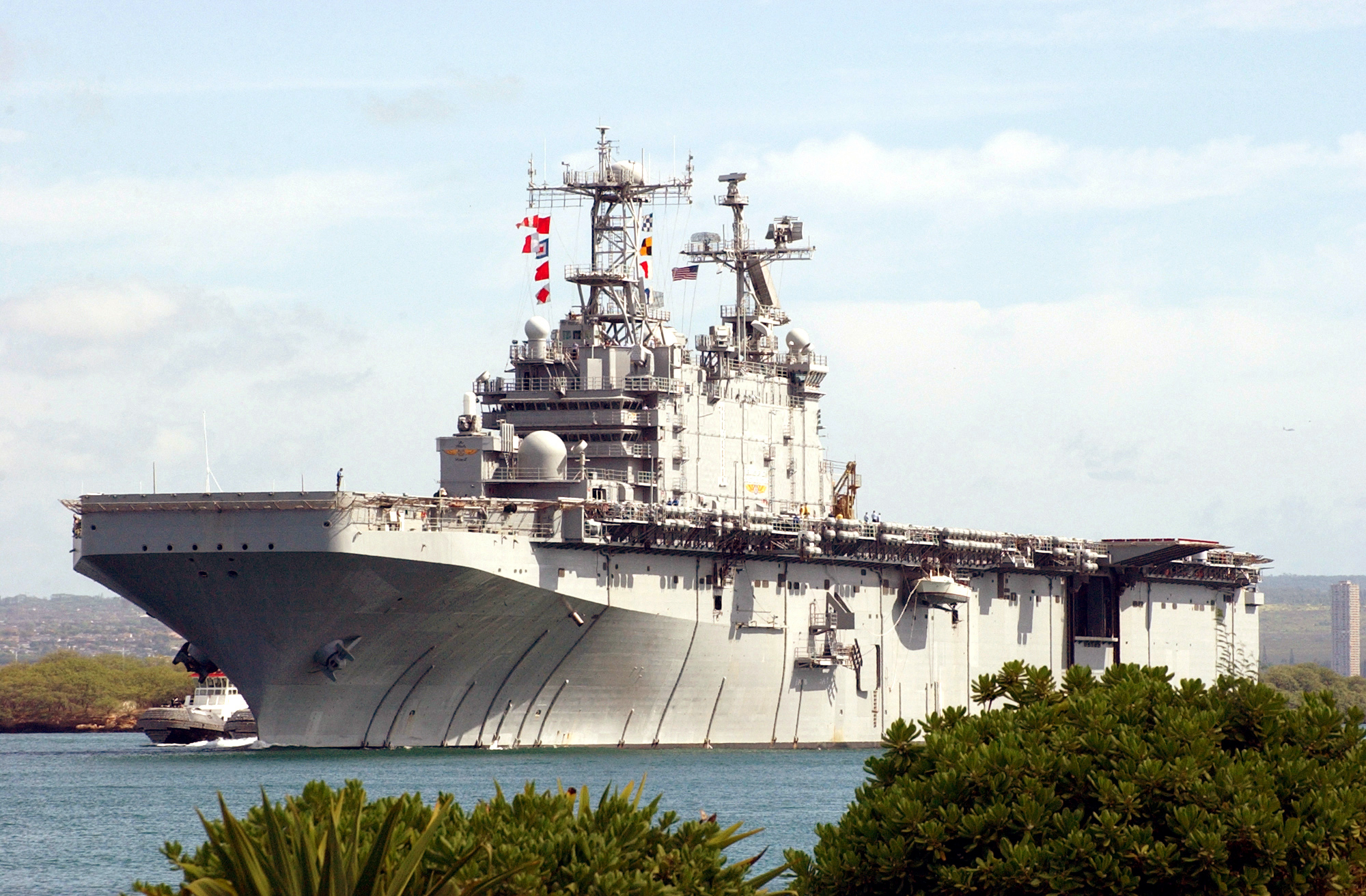
''Tarawa''-class
The ''Tarawa''-class LHA was the first to combine the features of the well deck of the Landing Ship Dock (LSD) or Landing Platform Dock (LPD) and the full flight deck of the Landing Platform Helicopter (LPH) into one ship. * * * * * USS ''Peleliu'' (LHA-5)''America''-class
The ''America''-class LHA would be a follow-on to the ''Wasp''-class LHD. The first two ships, ''America'' and ''Tripoli'', would not have a well deck, so as to dedicate more space to the support of air operations. This was criticized as a repeat of the mistakes of the LPH concept, and so it was decided that ''Bougainville'' and all future ships of this class would have a well deck. * * * * ref name=USNI_20221028> * (LHA-10) ref name=USNI_20220728>Amphibious Assault Ship (Multi-Purpose) (LHD)

''Wasp''-class
The well deck of the ''Tarawa''-class LHA was not designed to accommodate the Landing Craft Air Cushion (LCAC), which came into service just six years after the last of that class was completed. The ''Wasp''-class LHD and the later units of the ''America''-class LHA were designed to be LCAC compatible; the ''Wasp''-class could carry 3 LCACs. * * * * * * , scrapped after a 15 April 2021 pierside fire * *Landing Platform Helicopter (LPH)
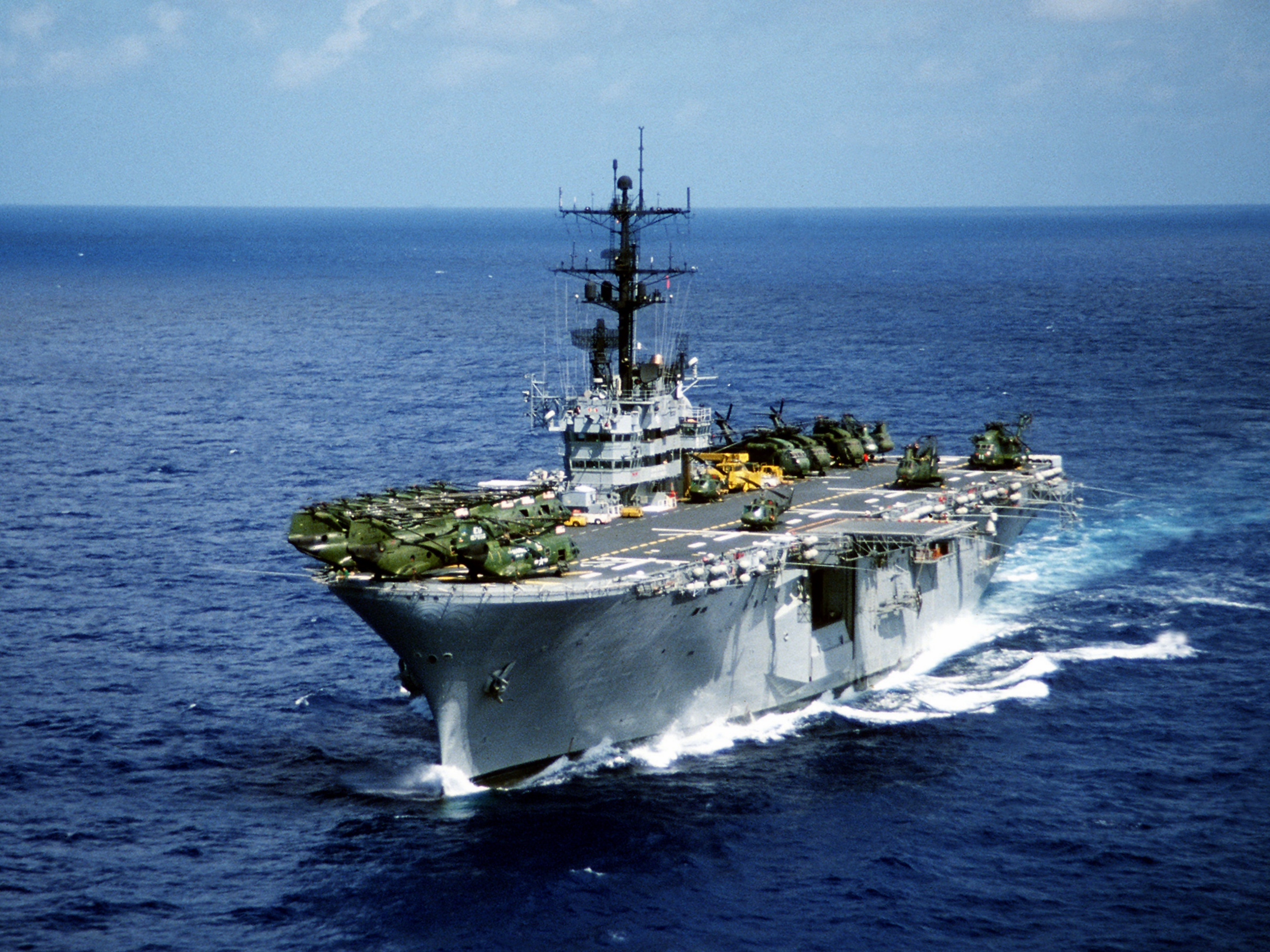 The Landing Platform Helicopter (LPH) would be the first ships to operate helicopters for large scale
The Landing Platform Helicopter (LPH) would be the first ships to operate helicopters for large scale ''Commencement Bay''-class
* , ex-CVE-106, conversion canceled''Iwo Jima''-class
As the 'definitive' LPH design, the ''Iwo Jima'' class would be the only class to be built as such, with sufficient 'hotel' accommodations for the embarked Marines. All other LPH ships would be conversions of aircraft carriers, and so had accommodation deficiencies (for example, some Marine units could not bunk together, and water distillation was insufficient to allow all personnel showers within a 24 hour period). After their retirement as amphibious warfare ships, one (''Inchon'') would be converted to carry minesweeping helicopters as a mine countermeasures support ship (MCS). All of these ships would be scrapped or sunk as targets by 2018. * * * * * * * , later MCS-12''Essex''-class
The following LPH ships were converted ''Essex''-class aircraft carriers, due to budget constraints with the construction of the ''Iwo Jima'' class ships. * , ex-CV-21 * , ex-CV-37 * ex-CV-45''Casablanca''-class
''Thetis Bay'' was converted from a ''Casablanca''-class escort carrier. Under the hull designation CVHA-1, she was the prototype for the LPH concept. * , ex-CVE-90, CVHA-1Landing Platform Dock (LPD)
The Landing Platform Dock (LPD) concept began as a compromise design, an attempt to build a ship with much more capability than a Landing Ship Dock (LSD) - the LPD superficially resembles an LSD with an enlarged flight deck - but without the expense of a LPH. The well deck is smaller than that of an LSD. Several of these ships were built with space dedicated for command capabilities. Two of these, ''LaSalle'' and ''Coronado'', would be redesignated as auxiliary command ships (AGF).''Raleigh''-class
* * * , later AGF-3''Austin''-class
* * * ''Cleveland''-subclass * * * * * , later AGF-11 * * ''Trenton''-subclass * , later INS ''Jalashwa'' * , later AFSB-15 * (LPD-16), not built''San Antonio''-class
The ''San Antonio''-class were the first LPDs designed to accommodate Landing Craft Air Cushion (LCAC); two could be carried. * * * * * * * * * * * * ref name=USNI_20220731> * * * * (LPD-32) ref name=USNI_20220728> * (LPD-33) ref name=USNI_20220728>Landing Ship Dock (LSD)



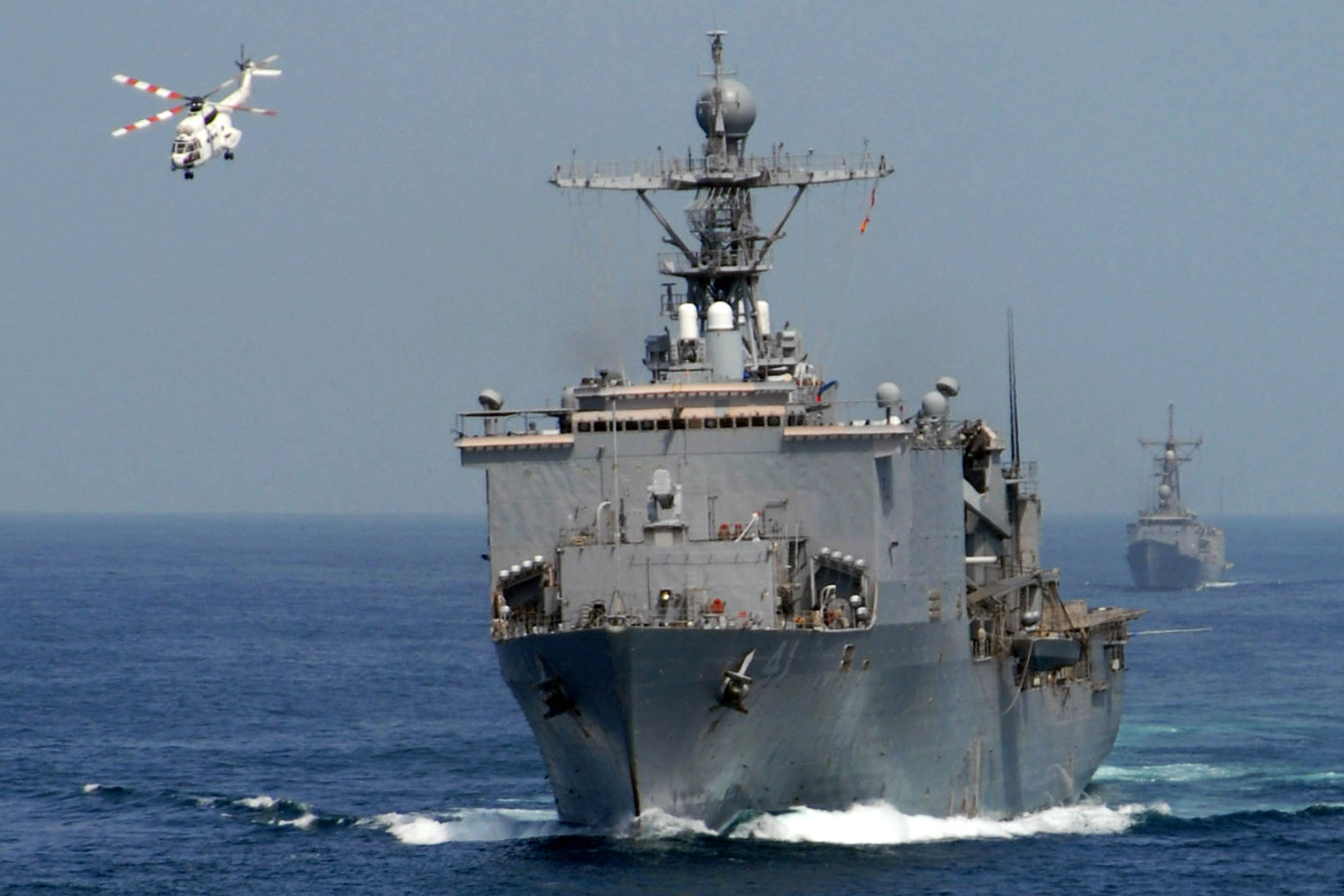
 The LSD came as a result of a British requirement during World War II for a vessel that could carry large landing craft across the seas at speed. The design was developed and built in the US for the Royal Navy and the US Navy. The first LSDs could carry 36 LCM at in a flooding well deck, the first ships with this capability. After the war they were modified with the addition of a temporary superdeck over the well deck; this could support helicopter operations, carry vehicles, or be removed for outsized cargo.
In December 2020 the U.S. Navy's Report to Congress on the Annual Long-Range Plan for Construction of Naval Vessels stated that it was planned that all LSDs would be placed Out of Commission in Reserve by 2027.
The LSD came as a result of a British requirement during World War II for a vessel that could carry large landing craft across the seas at speed. The design was developed and built in the US for the Royal Navy and the US Navy. The first LSDs could carry 36 LCM at in a flooding well deck, the first ships with this capability. After the war they were modified with the addition of a temporary superdeck over the well deck; this could support helicopter operations, carry vehicles, or be removed for outsized cargo.
In December 2020 the U.S. Navy's Report to Congress on the Annual Long-Range Plan for Construction of Naval Vessels stated that it was planned that all LSDs would be placed Out of Commission in Reserve by 2027.''Ashland''-class
* * * * , later MCS-7 * , later ARA ''Cándido de Lasala'' * * * , later ROCS ''Chung Cheng'' until 1985''Casa Grande''-class
* (LSD-9) To Britain as HMS ''Eastway'' * (LSD-10) To Britain as HMS ''Highway'' * (LSD-11) To Britain as HMS ''Northway'' * (LSD-12) To Britain as HMS ''Oceanway'' * * * * * * * , later ROCS ''Chung Cheng'' after 1985 * * * * USS ''Fort Snelling'' (LSD-23), canceled, sold for commercial service, later reacquired and converted to * USS ''Point Defiance'' (LSD-24), canceled * * *''Thomaston''-class
The ''Thomaston'' class would be the first class of LSDs capable of 20 knots. * * * * * * , later Brazilian ''Rio de Janeiro'' * , later Brazilian ''Ceará'' *''Anchorage''-class
The ''Anchorage'' class was basically the ''Thomaston'' class with the well deck enlarged (49 feet longer and 2 feet wider) to accommodate the new larger LCU-1610 class. * * * , later ROCS ''Hsu Hai'' * *''Whidbey Island''-class
The ''Whidbey Island''-class were the first LSDs designed to accommodate Landing Craft Air Cushion (LCAC) - up to 5 LCACs could be carried - and the first in which the helicopter deck would not be removable. * ref name=USNI_20220722> * * * * * * *''Harpers Ferry''-class
The ''Harpers Ferry''-class is basically the ''Whidbey Island''-class with more cargo capacity at the expense of a shorter well deck which could carry 2 LCACs. * * * *Mechanized Artillery Transports (APM)
The APM hull classification was short-lived; it was changed to Landing Ship Dock (LSD). * USS ''Ashland'' (APM-1) * USS ''Belle Grove'' (APM-2) * USS ''Carter Hall'' (APM-3) * USS ''Epping Forest'' (APM-4) * USS ''Gunston Hall'' (APM-5) * USS ''Lindenwald'' (APM-6) * USS ''Oak Hill'' (APM-7) * USS ''White Marsh'' (APM-8) * USS ''Lakehurst'' (APM-9)Amphibious Command Ship (LCC)

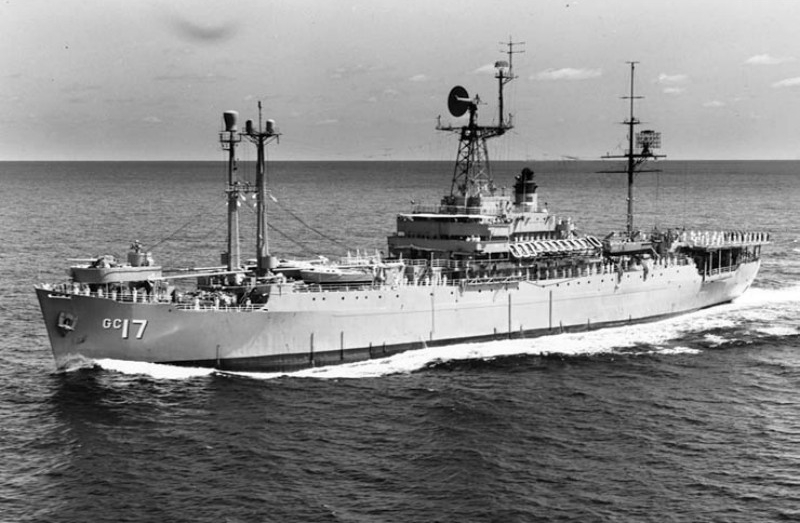
 All Amphibious Force Flagships (AGC) in service in 1969 were reclassed as Amphibious Command Ships (LCC), which should not be confused with the World War II era Landing Craft, Control (LCC).
All Amphibious Force Flagships (AGC) in service in 1969 were reclassed as Amphibious Command Ships (LCC), which should not be confused with the World War II era Landing Craft, Control (LCC).
''Mount McKinkey''-class
* USS ''Mount McKinley'' (LCC-7) * USS ''Eldorado'' (LCC-11) * USS ''Estes'' (LCC-12)''Adirondack''-class
* USS ''Pocono'' (LCC-16) * USS ''Taconic'' (LCC-17)''Blue Ridge''-class
The ''Blue Ridge''-class would be the only amphibious command ships purposely built as such by the US Navy, and the first and only class capable of exceeding 20 knots. Their hulls were based on the ''Iwo Jima''-class Landing Platform Helicopter (LPH) design due to the need for flat deck space for multiple antennas. After the retirement of the fleet flagships ruisersthese ships would be pressed into that role despite their lack of speed relative to carrier strike groups. * *Amphibious Force Flagship (AGC)


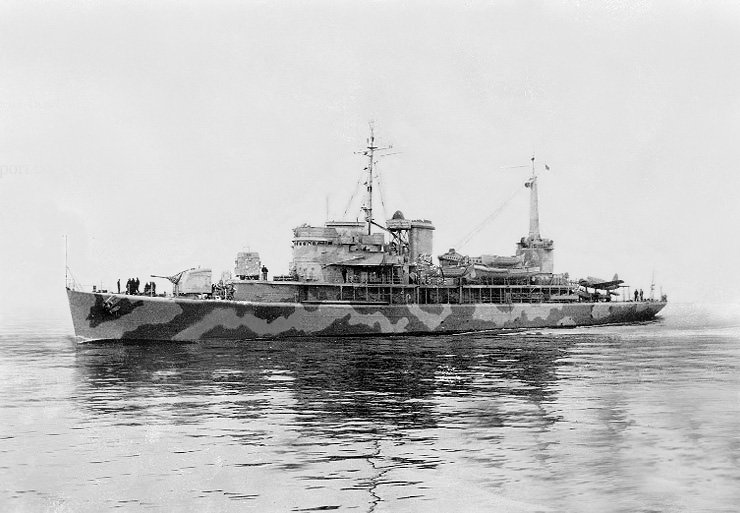 All Amphibious Force Flagships (AGC) in service in 1969 were reclassed as Amphibious Command Ships (LCC).
* USS ''Appalachian'' (AGC-1)
*
* USS ''Rocky Mount'' (AGC-3)
* USS ''Catoctin'' (AGC-5)
Troop transport conversion
* , ex-AP-66
Coast Guard cutter conversions
* USCGC ''Duane'' (WAGC-6), ex-WPG-33
*, ex-WPG-37
* USS ''Mount McKinley'' (AGC-7), later LCC-7
* USS ''Mount Olympus'' (AGC-8)
*
*
* USS ''Eldorado'' (AGC-11), later LCC-11
* USS ''Estes'' (AGC-12), later LCC-12
*
* USS ''Teton'' (AGC-14)
*
* USS ''Pocono'' (AGC-16), later LCC-16
* USS ''Taconic'' (AGC-17), later LCC-17
''Barnegat-class'' seaplane tender conversion
* USS ''Biscayne'' (AGC-18), ev-AVP-11
Presidential yacht (never used as a true AGC)
* USS ''Williamsburg'' (AGC-369), ex-PG-56
All Amphibious Force Flagships (AGC) in service in 1969 were reclassed as Amphibious Command Ships (LCC).
* USS ''Appalachian'' (AGC-1)
*
* USS ''Rocky Mount'' (AGC-3)
* USS ''Catoctin'' (AGC-5)
Troop transport conversion
* , ex-AP-66
Coast Guard cutter conversions
* USCGC ''Duane'' (WAGC-6), ex-WPG-33
*, ex-WPG-37
* USS ''Mount McKinley'' (AGC-7), later LCC-7
* USS ''Mount Olympus'' (AGC-8)
*
*
* USS ''Eldorado'' (AGC-11), later LCC-11
* USS ''Estes'' (AGC-12), later LCC-12
*
* USS ''Teton'' (AGC-14)
*
* USS ''Pocono'' (AGC-16), later LCC-16
* USS ''Taconic'' (AGC-17), later LCC-17
''Barnegat-class'' seaplane tender conversion
* USS ''Biscayne'' (AGC-18), ev-AVP-11
Presidential yacht (never used as a true AGC)
* USS ''Williamsburg'' (AGC-369), ex-PG-56
Amphibious Cargo Ship (LKA)

 All Attack Cargo Ships (AKA) in service in 1969 were reclassed as Amphibious Cargo Ships (LKA).
All Attack Cargo Ships (AKA) in service in 1969 were reclassed as Amphibious Cargo Ships (LKA).
''Arcturus''-class
* USS ''Libra'' (LKA-12)''Andromeda''-class
* USS ''Thuban'' (LKA-19) * USS ''Algol'' (LKA-54) * USS ''Arneb'' (LKA-56) * USS ''Capricornus'' (LKA-57) * USS ''Muliphen'' (LKA-61) * USS ''Yancey'' (LKA-93) * USS ''Winston'' (LKA-94) * USS ''Merrick'' (LKA-97)''Tolland''-class attack cargo ship
* USS ''Rankin'' (LKA-103) * USS ''Seminole'' (LKA-104) * USS ''Skagit'' (LKA-105) * USS ''Union'' (LKA-106) * USS ''Vermilion'' (LKA-107) * USS ''Washburn'' (LKA-108)''Tulare''-class
The ''Tulare'' would be the first AKA/LKA capable of 20 knots. * USS ''Tulare'' (LKA-112)''Charleston''-class
* * * * *Attack Cargo Ship (AKA)
All Attack Cargo Ships (AKA) in service in 1969 were reclassed as Amphibious Cargo Ships (LKA). * , ex-AK-18 * , ex-AK-19 * , ex-AK-20 * , ex-AK-21 * , ex-AK-22, later AE-20 * , ex-AK-23 * , ex-AK-24 * , ex-AK-25 * , ex-AK-26 * , ex-AK-27 * , ex-AK-28 * , ex-AK-53, later LKA-12 * , ex-AK-55 * , ex-AK-56 * , ex-AK-64 * , ex-AK-65 * , ex-AK-66 * , ex-AK-67 * , ex-AK-68, later LKA-19 * , ex-AK-69, later AE-30 * * * * * * * * * * * * * * , later AGS-15 * * , later AGS-16 * * * * * * * * * * * , later ARC-3 * * , later ARC-4 * * * * * , later LKA-54 * * , later LKA-56 * , later LKA-57 * , later AE-31 * * * , later LKA-61 * * * * * * * * * * * * * * * * * * * * * * * * * * * * * * * * , later LKA-93 * , later LKA-94 * * * , later LKA-97 * * * * * * , later LKA-103 * , later LKA-104 * , later LKA-105 * , later LKA-106 * , later LKA-107 * , later LKA-108 * , canceled 27 August 1945 * , canceled 27 August 1945 * , canceled 27 August 1945 The ''Tulare'' and the ''Charleston'' class would be the only AKA/LKAs capable of 20 knots. * , later LKA-112 * , later LKA-113 * , later LKA-114 * , later LKA-115 * , later LKA-116 * , later LKA-117Amphibious Transport (LPA)
All Attack Transports (APA) in service in 1969 were reclassed as Amphibious Transports (LPA). * * * * * * * * * * * * * * * * * * * * * * * * * * * * * * * * * * * * * * * The ''Paul Revere'' class would be the first and only class of APA/LPA capable of 20 knots. * *Attack Transport (APA)
Two transports with the hull symbol AP, and , had been configured as attack transports but were sunk in 1942 before the introduction of the APA hull symbol. All attack transports (APA) in service in 1969 were reclassified as amphibious transports (LPA).''Doyen''-class
* , ex-AP-2 * , ex-AP-18''Harris''-class
* , ex-AP-8 * , ex-AP-9 * , ex-AP-25 * , ex-AP-26 * , ex-AP-27 * , ex-AP-30. later AG-90 * , ex-AP-34 * , ex-AP-35''McCawley''-class
* , ex-AP-10 * , ex-AP-11''Heywood''-class
* , ex-AP-12 * , ex-AP-14 * , ex-AP-15 * , ex-AP-16''Harry Lee''-class
* , ex-AP-17''President Jackson''-class
* , ex-AP-37 * , ex-AP-38 * , ex-AP-39 * , ex-AP-59 * , ex-AP-60''Crescent City''-class
* , ex-AP-40 * * , ex-AP-64 * , ex-AP-65''Joseph Hewes''-class
* USS ''Joseph Hewes'' (APA-22), ex-AP-50, torpedoed 11 November 1942 off Morocco, approximately 100 killed''John Penn''-class
* , ex-AP-51''Edward Rutledge''-class
* USS ''Edward Rutledge'' (APA-24), ex-AP-52, torpedoed 12 November 1942 off Morocco, 15 killed''Arthur Middleton''-class
* , ex-AP-55 * , ex-AP-56 * , ex-AP-57''Bayfield''-class
* , ex-AP-78 * , ex-AP-79 * , ex-AP-80 * , ex-AP-81 * , ex-AP-82 * , ex-AP-83, later LPA-38 * , ex-AP-84 * , ex-AP-85 * , ex-AP-86 * , ex-AP-87 * , ex-AP-88 * , ex-AP-89, later LPA-44 * , ex-AP-90, later LPA-45 * , ex-AP-91 * , ex-AP-92 * , ex-AP-93 * * * * * * * * * * * * * * * * * *''Ormsby''-class
* , ex-AP-94 * , ex-AP-95 * , ex-AP-96''Sumter''-class
* , ex-AP-97 * , ex-AP-98 * , ex-AP-99 *''Windsor''-class
* , ex-AP-100 * * * * * * * *''Gilliam''-class
* * * * * * * * * * * * * * * * * * * * * * * * * * * * * * * *''Frederick Funston''-class
* , ex-AP-48, later T-AP-178 * , ex-AP-49, later T-AP-179''Haskell''-class
* * * * * * * * * * * * * * * * , later LPA-132 * * * * * * * * * * * * , later LPA-144 * * , later LPA-146 * , later LPA-147 * * * * * * * , later LPA-154 * * * , later LPA-157 * * * * * * * * * * * * , later LPA-169 * * * * , later LPA-173 * * * * , later LPA-177 * , later LPA-178 * , later LPA-179 * * APA-181 to APA-186, all unnamed, canceled, 1944 * * , later LPA-188 * * * * , later LPA-192 * * , later LPA-194 * * , later LPA-196 * * * , later LPA-199 * * * * * , later LPA-204 * * * * , later LPA-208 * * , later LPA-210 * * , later LPA-212 * , later LPA-213 * * , later LPA-215 * * * * * , later LPA-220 * * , later LPA-222 * , later LPA-223 * * , later LPA-225 * * , later LPA-227 * , later LPA-228 * , later LPA-229 * * , later LPA-231 * * , later LPA-233 * , later LPA-234 * , later LPA-235 * , later LPA-236 * , later LPA-237 * * , later LPA-239 * USS Harnett (APA-240) * * USS Hempstead (APA-241) * * USS Iredell (APA-242) * * USS Luzerne (APA-243) * * USS Medera (APA-244) * * USS Maricopa (APA-245) * * USS McLennan (APA-246) * * USS Mecklenburg (APA-247) * (* cancelled in 1945)''Paul Revere''-class
The ''Paul Revere'' class would be the first and only class of APA/LPA capable of 20 knots. * , later LPA-248 * , later LPA-249Amphibious Transport, Small (LPR)

 Fast Amphibious Transports with hull symbol LPR were converted destroyer escorts which had originally received the hull classification symbol APD; as of 1969 the remaining ships were reclassified as LPRs.
Fast Amphibious Transports with hull symbol LPR were converted destroyer escorts which had originally received the hull classification symbol APD; as of 1969 the remaining ships were reclassified as LPRs.
''Charles Lawrence''-class
* * *''Crosley''-class
* * * * * * * * * *High-speed Transport (APD)
High-speed Transports (APD) were convertedTransport Submarine (LPSS)
* , ex-APSS-282 * , ex-APSS-313, later IXSS-313 * , ex-APSS-315 * , ex-APSS-574Transport Submarine (APS, ASSP, APSS)
 * USS ''Argonaut'' (APS-1), ex-SM-1, sunk by Japanese destroyers off
* USS ''Argonaut'' (APS-1), ex-SM-1, sunk by Japanese destroyers off Inshore Fire Support Ship (LFR)
 * , ex-IFS-1
*
*
*
*
*
*
*
*
*
*
*
*
* , ex-IFS-1
*
*
*
*
*
*
*
*
*
*
*
*
Landing Craft Air Cushion (LCAC)
Landing Craft, Control (LCC)
Not to be confused with the later Amphibious Command Ship (LCC). During World War II a number of small boats were built to direct the movements of landing craft as they approached beaches. These were 56 feet in length, displaced 30 tons, and ran 13-16 knots in speed. They were equipped with multiple radios and SO radar (the same radar as on PT boats). During the invasion of southern France they were used to control drone minesweepers.Landing Craft Infantry (LCI)
The United States Navy built 932 Landing Craft Infantry ships in World War II.Landing Craft Mechanized (LCM)
The United States Navy built 11,144 landing craft Motorized, designated ''Landing Craft Mechanized (LCM)'' in World War II.Landing Craft Support (Large) (Mark 3), a.k.a. LCS(L)(3)
* USS ''LCS(L)(3)-1'' * USS ''LCS(L)(3)-2'' * USS ''LCS(L)(3)-3'' * USS ''LCS(L)(3)-4'' * USS ''LCS(L)(3)-5'' * USS ''LCS(L)(3)-6'' * USS ''LCS(L)(3)-7'' * USS ''LCS(L)(3)-8'' * USS ''LCS(L)(3)-9'' * USS ''LCS(L)(3)-10'' * USS ''LCS(L)(3)-11'' * USS ''LCS(L)(3)-12'' * USS ''LCS(L)(3)-13'' * USS ''LCS(L)(3)-14'' * USS ''LCS(L)(3)-15'' * USS ''LCS(L)(3)-16'' * USS ''LCS(L)(3)-17'' * USS ''LCS(L)(3)-18'' * USS ''LCS(L)(3)-19'' * USS ''LCS(L)(3)-20'' * USS ''LCS(L)(3)-21'' * USS ''LCS(L)(3)-22'' * USS ''LCS(L)(3)-23'' * USS ''LCS(L)(3)-24'' * USS ''LCS(L)(3)-25'' * USS ''LCS(L)(3)-26'' * USS ''LCS(L)(3)-27'' * USS ''LCS(L)(3)-28'' * USS ''LCS(L)(3)-29'' * USS ''LCS(L)(3)-30'' * USS ''LCS(L)(3)-31'' * USS ''LCS(L)(3)-32'' * USS ''LCS(L)(3)-33'' * USS ''LCS(L)(3)-34'' * USS ''LCS(L)(3)-35'' * USS ''LCS(L)(3)-36'' * USS ''LCS(L)(3)-37'' * USS ''LCS(L)(3)-38'' * USS ''LCS(L)(3)-39'' * USS ''LCS(L)(3)-40'' * USS ''LCS(L)(3)-41'' * USS ''LCS(L)(3)-42'' * USS ''LCS(L)(3)-43'' * USS ''LCS(L)(3)-44'' * USS ''LCS(L)(3)-45'' * USS ''LCS(L)(3)-46'' * USS ''LCS(L)(3)-47'' * USS ''LCS(L)(3)-48'' * USS ''LCS(L)(3)-49'' * USS ''LCS(L)(3)-50'' * USS ''LCS(L)(3)-51'' * USS ''LCS(L)(3)-52'' * USS ''LCS(L)(3)-53'' * USS ''LCS(L)(3)-54'' * USS ''LCS(L)(3)-55'' * USS ''LCS(L)(3)-56'' * USS ''LCS(L)(3)-57'' * USS ''LCS(L)(3)-58'' * USS ''LCS(L)(3)-59'' * USS ''LCS(L)(3)-60'' * USS ''LCS(L)(3)-61'' * USS ''LCS(L)(3)-62'' * USS ''LCS(L)(3)-63'' * USS ''LCS(L)(3)-64'' * USS ''LCS(L)(3)-65'' * USS ''LCS(L)(3)-66'' * USS ''LCS(L)(3)-67'' * USS ''LCS(L)(3)-68'' * USS ''LCS(L)(3)-69'' * USS ''LCS(L)(3)-70'' * USS ''LCS(L)(3)-71'' * USS ''LCS(L)(3)-72'' * USS ''LCS(L)(3)-73'' * USS ''LCS(L)(3)-74'' * USS ''LCS(L)(3)-75'' * USS ''LCS(L)(3)-76'' * USS ''LCS(L)(3)-77'' * USS ''LCS(L)(3)-78'' * USS ''LCS(L)(3)-79'' * USS ''LCS(L)(3)-80'' * USS ''LCS(L)(3)-81'' * USS ''LCS(L)(3)-82'' * USS ''LCS(L)(3)-83'' * USS ''LCS(L)(3)-84'' * USS ''LCS(L)(3)-85'' * USS ''LCS(L)(3)-86'' * USS ''LCS(L)(3)-87'' * USS ''LCS(L)(3)-88'' * USS ''LCS(L)(3)-89'' * USS ''LCS(L)(3)-90'' * USS ''LCS(L)(3)-91'' * USS ''LCS(L)(3)-92'' * USS ''LCS(L)(3)-93'' * USS ''LCS(L)(3)-94'' * USS ''LCS(L)(3)-95'' * USS ''LCS(L)(3)-96'' * USS ''LCS(L)(3)-97'' * USS ''LCS(L)(3)-98'' * USS ''LCS(L)(3)-99'' * USS ''LCS(L)(3)-100'' * USS ''LCS(L)(3)-101'' * USS ''LCS(L)(3)-102'', museum ship * USS ''LCS(L)(3)-103'' * USS ''LCS(L)(3)-104'' * USS ''LCS(L)(3)-105'' * USS ''LCS(L)(3)-106'' * USS ''LCS(L)(3)-107'' * USS ''LCS(L)(3)-108'' * USS ''LCS(L)(3)-109'' * USS ''LCS(L)(3)-111'' * USS ''LCS(L)(3)-112'' * USS ''LCS(L)(3)-113'' * USS ''LCS(L)(3)-114'' * USS ''LCS(L)(3)-115'' * USS ''LCS(L)(3)-116'' * USS ''LCS(L)(3)-117'' * USS ''LCS(L)(3)-118'' * USS ''LCS(L)(3)-119'' * USS ''LCS(L)(3)-120'' * USS ''LCS(L)(3)-121'' * USS ''LCS(L)(3)-122'' * USS ''LCS(L)(3)-123'' * USS ''LCS(L)(3)-124'' * USS ''LCS(L)(3)-125'' * USS ''LCS(L)(3)-126'' * USS ''LCS(L)(3)-127'' * USS ''LCS(L)(3)-128'' * USS ''LCS(L)(3)-129'' * USS ''LCS(L)(3)-130''Landing Craft Tank (LCT)
The United States Navy built 1,394 landing craft tank, designated ''Landing Craft Tank (LCT)'' in World War II. Those that were still in use in 1949 were redesignated as Landing Craft, Utility.Landing Craft Utility (LCU)
The United States Navy built the LCU 1466, 1610 and 1627 classes after World War II.Landing Ship Medium (LSM)
Towards the end of World War II the United States Navy built 558 Landing Ship Medium (LSM) type vessels across three classes.Landing Ship, Tank (LST)
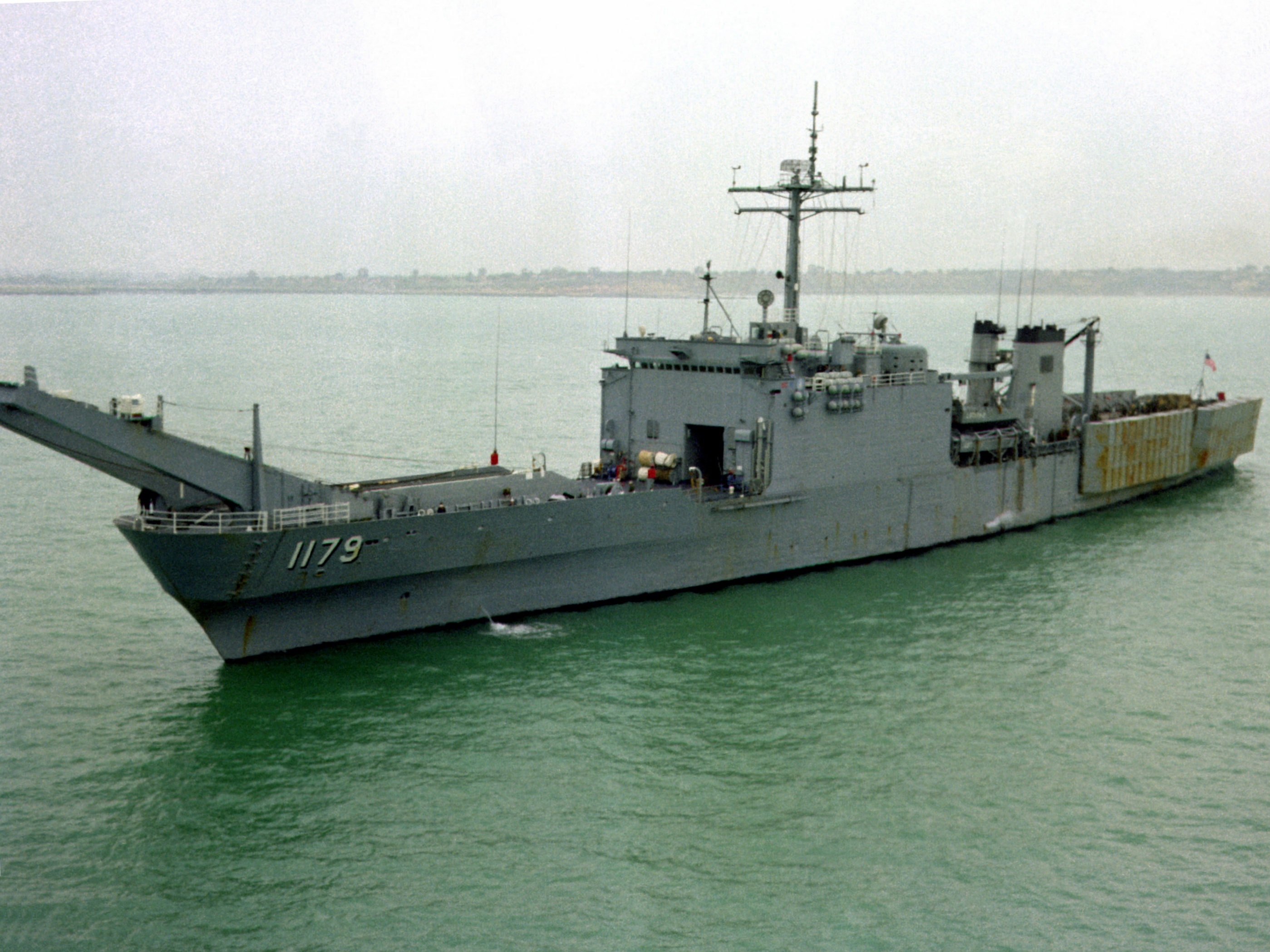 The United States Navy built nearly 1,200 tank landing ships, classified as "Landing Ship, Tank" or "LST", from the World War II-era up through the early 1970s. The ''Newport'' class, which entered service in 1969, would be the last class built and the only class capable of exceeding 20 knots. The 1987 introduction of Landing Craft Air Cushion (LCAC) — which allowed for over-the-horizon amphibious landings onto a far larger number of beaches — made LSTs obsolete, but they remained with the fleet for another decade because they were the only means by which the hundreds of thousands of gallons of motor vehicle fuel needed by a Marine Expeditionary Force could be landed. Only the development of tankers with the Offshore Petroleum Discharge System (OPDS) and the later development of special fuel bladders which gave the LCACs a tanker capability allowed for their retirement.
The United States Navy built nearly 1,200 tank landing ships, classified as "Landing Ship, Tank" or "LST", from the World War II-era up through the early 1970s. The ''Newport'' class, which entered service in 1969, would be the last class built and the only class capable of exceeding 20 knots. The 1987 introduction of Landing Craft Air Cushion (LCAC) — which allowed for over-the-horizon amphibious landings onto a far larger number of beaches — made LSTs obsolete, but they remained with the fleet for another decade because they were the only means by which the hundreds of thousands of gallons of motor vehicle fuel needed by a Marine Expeditionary Force could be landed. Only the development of tankers with the Offshore Petroleum Discharge System (OPDS) and the later development of special fuel bladders which gave the LCACs a tanker capability allowed for their retirement.
Landing Ship, Tank, Hospital (LSTH)
Atlantic Tank Landing Ship (ATL)
The ATL hull classification was short-lived; it was changed to Landing Ship Tank (LST). * USS ''ATL-1'', later USS ''LST-1''Vehicle Landing Ship (LSV)

 The World War II LSVs were converted from cruiser minelayers (CM) and netlayers (AN). After the war most were slated to become mine countermeasures ships (MCS), but only two were actually converted.
* , former CM-6, AP-106, later MCS-1
* , former CM-7, AP-107, later MCS-2
* , former AN-3, AP-108, later MCS-3 canceled
* , former AN-4, AP-109, later MCS-4 canceled
* , former AN-1, AP-160, later MCS-5 canceled
* , former AN-2, AP-161, later AKN-6
The post-WW2 LSVs were among the first roll-on/roll-off cargo ships.
* , former T-AK-269, later T-AKR-7
* , former LSD-23, T-AK-273
* , later T-AKR-9
The World War II LSVs were converted from cruiser minelayers (CM) and netlayers (AN). After the war most were slated to become mine countermeasures ships (MCS), but only two were actually converted.
* , former CM-6, AP-106, later MCS-1
* , former CM-7, AP-107, later MCS-2
* , former AN-3, AP-108, later MCS-3 canceled
* , former AN-4, AP-109, later MCS-4 canceled
* , former AN-1, AP-160, later MCS-5 canceled
* , former AN-2, AP-161, later AKN-6
The post-WW2 LSVs were among the first roll-on/roll-off cargo ships.
* , former T-AK-269, later T-AKR-7
* , former LSD-23, T-AK-273
* , later T-AKR-9
Patrol Craft, Control (PCC)
 Thirty-five submarine chasers were converted into amphibious landing control vessel during World War II and reclassified as Patrol Craft, Control after the war. Extra personnel (eight radiomen, two signalmen, one quartermaster and two communications officers), accommodations and improved radar and communications equipment were added. PCs proved exceptionally adept as Control Vessels, guiding waves of landing craft during numerous amphibious landings in the European and Pacific Theaters.
* PCC-549, ex-PC-549
* PCC-555, ex-PC-555
* PCC-563, ex-PC-563
* PCC-578, ex-PC-578
* USS ''Lenoir'' (PCC-582), ex-PC-582
* USS ''Houghton'' (PCC-588), ex-PC-588
* USS ''Metropolis'' (PCC-589), ex-PC-589
* ''PCC-598'', ex-PC-598
* PCC-802, ex-PC-802, later to Republic of Korea as ''Sam Gak San'' (PC-703)
* PCC-803, ex-PC-803
* ''PCC-1136'', ex-PC-1136
* ''PCC-1137'', ex-PC-1137
* USS ''Escandido'' (PCC-1169), ex-PC-1169
* USS ''Guymon'' (PCC-1177), ex-PC-1177
* USS ''Kewaunee'' (PCC-1178), ex-PC-1178
* USS ''Martinez'' (PCC-1244), ex-PC-1244
* USS ''Ukiah'' (PCC-1251), ex-PC-1251
Thirty-five submarine chasers were converted into amphibious landing control vessel during World War II and reclassified as Patrol Craft, Control after the war. Extra personnel (eight radiomen, two signalmen, one quartermaster and two communications officers), accommodations and improved radar and communications equipment were added. PCs proved exceptionally adept as Control Vessels, guiding waves of landing craft during numerous amphibious landings in the European and Pacific Theaters.
* PCC-549, ex-PC-549
* PCC-555, ex-PC-555
* PCC-563, ex-PC-563
* PCC-578, ex-PC-578
* USS ''Lenoir'' (PCC-582), ex-PC-582
* USS ''Houghton'' (PCC-588), ex-PC-588
* USS ''Metropolis'' (PCC-589), ex-PC-589
* ''PCC-598'', ex-PC-598
* PCC-802, ex-PC-802, later to Republic of Korea as ''Sam Gak San'' (PC-703)
* PCC-803, ex-PC-803
* ''PCC-1136'', ex-PC-1136
* ''PCC-1137'', ex-PC-1137
* USS ''Escandido'' (PCC-1169), ex-PC-1169
* USS ''Guymon'' (PCC-1177), ex-PC-1177
* USS ''Kewaunee'' (PCC-1178), ex-PC-1178
* USS ''Martinez'' (PCC-1244), ex-PC-1244
* USS ''Ukiah'' (PCC-1251), ex-PC-1251
Expeditionary Fast Transport (EPF)
''Spearhead''-class
* * * * * * * * * * * * * *Expeditionary Mobile Base (ESB)
''Lewis B. Puller''-class
* Note there is no ESB-1 or ESB-2, the ESB and ESD hulls have one sequence * * * * * ref name=USNI_20221024>Expeditionary Transfer Dock (ESD)
''Montford Point''-class
* *Littoral Combat Ship (LCS)
''Freedom''-class
* * * * * * * * * * * * * * * *''Independence''-class
* * ref name=USNI_20220914> * * * * * * * * * * * * * * * * *Barracks Ships
Barracks ships are auxiliaries that are used in a variety of roles, not only for amphibious warfare.Self-Propelled Barracks Ship (APB)
Non Self-Propelled Barracks Ship (APL)
Offshore Petroleum Distribution System (OPDS) ships
 OPDS ships support amphibious operations by pumping needed fuel ashore without the need for port facilities. They do not have unique hull classification symbols.
OPDS ships support amphibious operations by pumping needed fuel ashore without the need for port facilities. They do not have unique hull classification symbols.
Pump vessels
* USNS ''Vice Adm. K. R. Wheeler'' (T-AG-5001)Tankers
* * List of United States Navy oilers § Other transport oilersSee also
* Amphibious assault ship * Amphibious warfare ship * List of current ships of the United States Navy * List of US Navy ships sunk or damaged in action during World War II § Amphibious ships *References
Notes
Sources
*External links
Museum shipsUSS LCI(L)-713
- Amphibious Forces Memorial Museum, Portland, OR * USS LCI(L)-1091 - Humboldt Bay Naval Sea/Air Museum, Eureka, CA
USS LCS(L)(3)-102
- Landing Craft Support Museum, Mare Island, CA
USS LST-325
- The USS LST Ship Memorial, Evansville, IN
USS LST-393
- USS LST 393 Veterans Museum, Muskegon, MI * USS Stark County (LST-1134) - Surat Thani, Thailand {{DEFAULTSORT:Amphibious warfare ships Amphibious warfare vessels of the United States Navy Lists of ships of the United States United States amphibious warfare ships